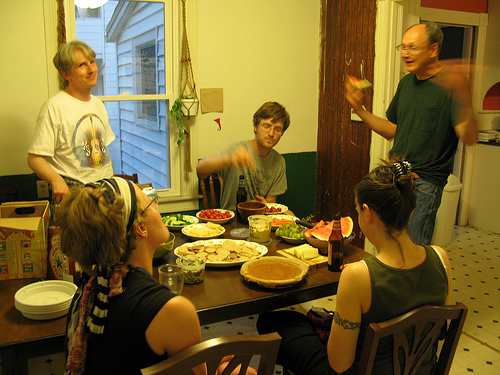Q: What Are Ways that Sharing Home Ownership Can Help Avert Foreclosures?
A: Sharing is one solution to an unforgiving housing crisis, and it may even be a trend. In the past, refinancing or drawing from home equity helped families ride out the financial uncertainty that accompanies a job loss, a divorce, disability, a death in the family, or some other change.
Today, it’s very common for homeowners to have little or no equity to use when these predicaments arise. Even worse, many people are “upside down” on their mortgage–paying off a $500,000 loan on a house that’s now worth $300,000.
Lately, my law office has heard from a handful of people considering sharing a home as a solution to this problem. Here are some examples, based, roughly, on real stories:
- Henry, whose wife passed away and who can no longer afford to pay his mortgage alone, invites his friends Justine and Paula (a couple) to build an addition onto his home. They plan to all share ownership of the home and to share use of certain areas, including the kitchen, patio, garage, and laundry room. All are nearing retirement, and hope to age together in a supportive environment.
- Claudia, a recently divorced mom, shares ownership of her three-bedroom home with Ana, also a single mother.
- After he is laid off from his job, Fred sells half of his duplex to his long-time renters.
These sharing arrangements are triggered by financial necessity, but they benefit everyone in other ways. Companionship, support, and the ability to share resources, day-to-day costs, energy, and responsibilities (such as childcare, errands, chores, and cooking) are all benefits of shared housing.
Let’s look more closely at how this can work, financially and legally.
At first glance, buying part of a home that has no equity (or even negative equity) might sound like a risky proposal. A homebuyer with good credit, stable income, and some savings can find great deals right now, so why might they want to buy half of a home that’s in a financial hole?
The answer is: they probably don’t—for many of those folks, it probably makes more financial sense to start fresh and buy one of those cheap homes on the market right now.
But for people with poor credit or no savings, this could be a good opportunity to buy a home, or at least part of one. For the existing homeowners, the arrangement means they can avoid foreclosure, stay in their home, and preserve their credit. It can also give the homeowner a significant break – temporarily or permanently – from monthly mortgage payments. Depending on how the arrangement is structured, it’s possible that everyone can benefit.
Let's consider a detailed example of this type of arrangement.
Keri owns and lives in a four bedroom home, and rents two bedrooms to her friends Sebastian and Dulce Tejeda. When Keri is forced to quit her job due to health problems, there is no way that she can keep up with the $4000 monthly mortgage payments, even with the Tejedas paying $2000 per month in rent.
For their part, the Tejedas make good money, but they have very little savings and poor credit; it’s unlikely they’d qualify for a home loan. The value of Keri’s house has dropped to a market value of about $400,000, and there’s a balance of $500,000 on her mortgage.
Keri sees sharing as a solution, and she proposes to have the Tejedas take over the entire $4000 monthly payments and begin gaining partial ownership of the home. This would give Keri relief from her largest monthly expense, and provide the Tejedas with the opportunity to become homeowners and, down the road, start building equity. For all of them, it means staying in the home they love and living with people they enjoy.
The Tejedas are taking the risk of buying a home with a negative value. To account for this, Keri could agree to give the Tejedas a larger share of equity in proportion to their payments.
Let’s imagine that Keri has already made 60 payments on the home, and there are approximately 300 payments left to be made before the home is paid off. Keri and the Tejedas create a “point” system and decide that each payment that Keri has made or makes in the future entitles her to 1 point and each payment the Tejedas make entitle them to 1.5 points. (Note that the parties could decide on any number of ways to allocate points, based on what they feel is fair, on how they plan to allocate other expenses, such as insurance and property tax, on how they share the mortgage interest deduction, on the value of the house at purchase, on the current value, and so on.) If and when the home sells, they’ll divide the equity by calculating the number of points each has relative to the total number of points.
To illustrate, imagine that the Tejedas make all the mortgage payments for 5 years, a total of 60 payments. Keri made 60 payments before the Tejedas bought in, so at this point the Tejedas and Keri have each made 60 payments. Keri is entitled to 60 points (60 x 1, 40% of the total points), and the Tejedas to 90 points (60 x 1.5, 60% of the total points). If the home then sells with $100,000 in equity, Keri gets $40,000 and the Tejedas get $60,000. The extra $20,000 for the Tejedas is their reward for taking the risk and riding out the hard times with Keri. Keri, in the meantime, has kept her home and preserved her credit, while living rent and mortgage free for five years.
Now for the legal part. There’s a lot to think about — more than I can cover in the space of this article. But here are a few of the key issues: First, if Keri deeds part of her house to the Tejedas, it could trigger the “due on transfer” requirement that’s included in the fine print of most loans and that says if a homeowner transfers the house to anyone else, the entire balance of the loan is due immediately.
It has always been questionable whether lenders would know that a partial transfer was made, so long as the loan is paid currently. Now, in the current economic and banking climate, it is additionally questionable whether a lender would care to enforce a due on transfer clause on a fully paying loan. Nevertheless, it’s still risky to do this hoping the lender either doesn’t notice or doesn’t care to act.
One alternative is to seek the lender’s permission. It might work, but it won’t be easy getting the right people on the phone. If the lender does agree, chances are they will want all owners to sign on to and take responsibility for the mortgage, or get a new mortgage at a higher interest. Having all owners on the loan may have benefits, especially if the new owners hope to deduct mortgage interest payments from their income taxes. But sharing responsibility for a mortgage has its risks, so owners should have clear agreements about who is responsible for what, how they will handle a default, and so on.
Another way to get around the due on transfer issue would be to use a “lease-to-own” arrangement, involving a regular lease combined with a purchase option.
Typically, the owner tacks a premium onto the monthly lease payment, and gives the renters an option to purchase the property at an agreed-upon price within a certain period of time (usually 1 to 5 years). In the example above, the Tejedas pay $2000 per month in rent. Under a lease-to-own agreement with Keri, they might start paying $3000 per month. The extra $1000, as well as all or part of their regular $2,000 lease payment, will be credited to their eventual purchase of half the home. The Tejeda’s extra payment might also be credited with a multiplier like 1.33 or 1.5 times, in order to compensate them for taking the risk. (The Tejedas are taking a risk that they could lose this investment if they decide to back out of the arrangement, or if Keri loses the house.) The purchase will take place at a later date when it makes sense to refinance the home and transfer title to all three names.
No matter how the parties want to structure their sharing arrangement, they should each consult with lawyers, and be sure to get the details of the agreement in writing. Co-owners should talk through contingencies in advance: What if one party goes bankrupt? What if there is a default? What happens if one party wants or needs to refinance? What happens when one party wants to sell out? What if the house is still “upside down” when one owner wants out?
If you do the work to get through the legal gobbledygook, you may very well have a great shared housing arrangement in the end. If you’d like to read about a real-life example, see "How to Share a House: A Case Study," here at Shareable.net!
This article was written with help and feedback from attorneys Charles Spiegel, Lise K. Strom, and Emily Doskow.









